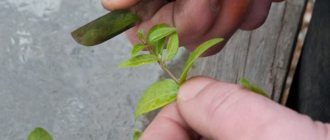Is it possible to plant phlox in the fall: advantages and disadvantages of autumn planting
Like many other flowers, phlox can, in principle, be planted both in spring and autumn, and with a large lump of earth, careful replanting is possible even in a blooming state, that is, in summer. However, many gardeners prefer to do this in the spring, especially in those regions where harsh winter comes early. However, autumn planting in not too cold areas has many advantages, for example:
- in the fall the gardener is given more time for planting;
- working with the soil in autumn is easier than in early spring;
- as a rule, watering after autumn planting is sufficient due to frequent rains;
- In autumn it is easier to choose high-quality planting material of the desired variety.
The disadvantages of autumn planting are mainly that there is a high risk of early frosts, which can destroy plants that have not yet had time to fully take root. Therefore, at latitudes north of Moscow, autumn planting is not recommended by experts. According to most indicators, autumn planting of phlox is preferable to spring: at this time, flowers can more easily tolerate being removed from the ground and transferred to a new place of residence.
Pests and diseases
Under unfavorable growing conditions and improper care, plants can be affected by various diseases:
- Fungal diseases of the roots are indicated by fading color and wilting of the bush.
- Powdery mildew can be recognized by a whitish coating on the leaves and shoots.
- With Phoma, the stem cracks and the leaves turn yellow and curl.
- Leaf spotting can be recognized by brown spots that are increasingly increasing in size.
All diseases must be treated with special medications that can be purchased at gardening stores.
Among the pests on phlox you can find caterpillars and butterflies, slobbering pennies, slugs, and nematodes. You can get rid of them using folk remedies or insecticides.
Beautiful, long-blooming and spectacular phloxes can be propagated and grown independently. With proper planting and good care, bright inflorescences will decorate the garden all summer.
0
( 17 ratings, average: 4.47 out of 5)
Back
How to build a garden house with your own hands
MORE
When to plant perennial phlox in open ground in the fall
The specific timing of autumn planting of perennial phlox depends on many factors; The exact date of this procedure cannot be indicated. For example, planting time differs depending on the variety: those that bloom earlier or in the middle are planted earlier (already in August), and those that bloom late are planted a little later. It is important that by the time of transplantation, the plants have time to form well-formed renewal buds, from which new shoots will begin to grow next year. This requires at least a couple of weeks after flowering has ended.
While phloxes are spending their energy on flowering, new buds are still almost not developing.
It is important to focus on the usual timing of the onset of cold weather. And if night temperatures of about 0 ° C are not very dangerous for planted flowers, then stronger frosts can already damage unrooted roots, so planting must be completed at least a month before the arrival of serious frosts. It is better to choose a cool, cloudy day for planting: as a rule, phloxes are planted when average daily air temperatures are already around 10–15 °C. If the forecast is unfavorable, you need to be guided by the real weather: it happens that an unexpected cold snap lasts only a few days and it is better to wait it out.
If real cold comes too early, it is better to postpone planting phlox until spring.
The approximate planting time for perennial phlox in the middle zone and, in particular, the Moscow region is the whole of September. In the north-west of the country it is better to complete the work before the middle of this month; in most regions of the Urals and Siberia this is done at the end of summer or the very beginning of autumn. In the south, where the weather is relatively warm even in November, the entire month of October can be devoted to planting phlox.
Some experienced gardeners also practice seed propagation of perennial phlox. This is not to say that this is an easy path; As a rule, seeds are sown for seedlings in boxes in early spring. However, winter sowing of seeds directly into open ground is also possible; They do this already on frozen ground, at about the same time when some vegetable crops are sown before winter.
Types and varieties
The plant is divided into bush and ground cover species .
Low-growing perennial
Creeping or groundcover bushes can have stems from 5 to 40 cm long. They grow well in width, so they are often used to decorate an alpine hill. The most popular low-growing phloxes are the following varieties:
- Forked . A plant with slightly pubescent stems and unusually shaped flowers. The petals of the buds are dissected, which makes it seem like there are not one, but several flowers. The color of the inflorescences is mainly blue and white.
- Douglas . The bush, up to 10 cm high, is distinguished by a dense cushion of flowers, which are located on hard stems. The color can be purple, white, lilac. Flowering continues from May to June.
- Phlox subulate . A popular low-growing plant with stems up to 18 cm long. When planted in open ground, awl-shaped phlox covers a large area of soil with purple, white or pink inflorescences. The plant first blooms in May-June, after which beautiful numerous flowers bloom on the bush again in August and September.
Gallery: phlox (25 photos)
Bush perennial
Bushes of the plant are the most common, and they most often decorate flower beds in the garden . They are short - up to one meter high and tall - more than a meter high.
Low growing varieties:
- Orange Perfection is a variety with salmon-colored buds that appear pink in bright sun.
- Tiara is an unpretentious and beautiful plant with emerald greenery, against which the inflorescences stand out with their snow-white color.
- Sherbet Cocktail is a fast-growing shrub with olive-colored flowers.
Tall varieties:
- Magic Blue is a variety that blooms with scarlet, blue, lilac or white flowers that bloom in early summer and decorate the garden until September.
- Tenor is a profusely flowering plant with bright purple-red inflorescences.
- Niki is a perennial bush up to 1.2 meters high. At the beginning of summer, dark, rich flowers bloom on it, which fade only in September.
- Natasha is a plant up to one and a half meters high with blue and white buds.
- Windsor is a one and a half meter bush, distinguished by elongated oval-shaped leaves and the color of the inflorescences from white to carmine.
How to plant phlox correctly in the fall
In the vast majority of cases, perennial phloxes are planted in the fall with pieces of an adult bush, that is, “roots.” Cuttings and seed propagation are used less frequently and, as a rule, the timing of these procedures differs.
How to choose a landing site
Choosing a place to plant phlox is not difficult. They prefer to be planted not in the sunniest place, especially for varieties with dark colors. Phlox love a little partial shade, so they are often located near low trees. In addition to creating shade (so that the flowers do not fade), these trees help plants survive the winter because they promote snow retention. It is desirable that there is a slight slope of the area: stagnant water is harmful to phlox.
Even temporary shade from tall bushes prevents premature fading of flowers
Phloxes do not thrive in every climate: for example, in the middle zone, where I spent my youth, where there is enough moisture and no intense heat, they bloom perfectly in every front garden. In the same place where I had to live for the second half of my life, the rains are rare and the heat is excessive, and it is not possible to grow good phloxes.
The soil for phlox should be moderately moist, neutral or slightly acidic (pH about 6.5). Its structure should allow air to penetrate well to the roots, so these flowers grow poorly on clay; other soils (loam, sandy loam and even sand) are quite suitable. Phlox are not picky about their neighbors, but they should not be planted next to large trees that take moisture and nutrients from the soil.
Preparing the site and soil for planting phlox in the fall
Phlox have fairly strong roots that penetrate deep into the soil. Therefore, the area for planting them is well dug up beforehand (2-3 weeks in advance). At the same time, weed rhizomes and other debris are removed and fertilizers are added. Clay soils are corrected by adding sand, acidic soils are limed in advance. As fertilizer, it is enough to take a bucket of humus or compost per 1 m2 or buy special fertilizers for phlox; the dosage is in the instructions on the package. The holes (25–30 cm deep and wide) are prepared immediately before planting. The distance between them depends on the type of flower (its height) and can range from 35 to 50 cm.
Digging the soil must be deep and thorough
Selection and preparation of planting material
To plant phlox in the fall, choose large divisions, which take root better and withstand winter more easily. The division should have:
- at least two thick stems;
- at least two well-defined renewal buds near the roots;
- dense, coarsened stem structure;
- absence of traces of mechanical damage and rotting of both roots and aerial parts.
The shoots of purchased seedlings are cut off at a height of about 25 cm. If the roots are bare, they are trimmed slightly (if they are too long, maybe by a third). If you plant a plant with a good earthen clod, you can cut off only the top (withered inflorescence). In this case, it’s a good idea to leave 3-4 strong leaves: they will help the plant to take root in a new place.
There must be no doubt about the health of the division.
Technologies for planting and sowing phlox in open ground in autumn
Planting phlox with fragments of an adult plant is done in a way well known to any gardener:
- In the designated areas, dig holes large enough to accommodate the roots. A 3-4 cm layer of clean coarse sand is poured onto the bottom.
- Fertilizers are added to the hole: a handful of humus, a glass of wood ash, 1 tbsp. a spoonful of superphosphate. After adding a couple of handfuls of excavated soil, mix everything well and water generously. Landing is carried out “in the mud”.
The holes are prepared similarly to those for most perennial flowers.
- Phlox is planted at such a depth that the renewal buds are 3–5 cm below the soil level. Straighten the roots and then cover them with the removed soil.
The roots should be located freely in the hole
- If the soil is too dry, additionally water and mulch the plantings with humus or peat.
Seedlings from pots are planted without additional deepening.
If a gardener decides to sow the seeds of perennial phlox before winter, he must prepare the bed in advance and collect the seeds in mid-September. They are sown in November (or even December) in previously prepared furrows, to a depth of about 1 cm. They must be sown thickly: the germination rate of the seeds in this case is low. The seeds are sprinkled with previously prepared soil, after which the crops are insulated with dry leaves or coniferous spruce branches, which are removed with the arrival of spring.
Phlox seeds are quite large and easy to sow.
Cuttings of phlox in the fall are rarely carried out, since it is much more reliable to root green cuttings, which is done in mid-summer.
Video: planting phlox in autumn
Botanical description
Phlox are diverse even within the same species: their “appearance” changes depending on the climate in which they grow. For example, at an altitude of 4000 meters they are bryophytes and low-growing, their stems are branched and covered with evergreen leaves, and the height of the plants is from 5 cm to 25 cm. In more favorable conditions, phloxes are erect bushes with a height of 30 cm to 180 cm. And there are and subshrubs.
- Clematis pruning and wrapping for winter
According to the flowering time, they are spring (early), summer (middle) and summer-autumn (late). The culture is dominated by species and varieties of erect phlox. Their leaves are sessile, opposite, entire, oval-lanceolate or elongated-ovate.
Phlox flowers are from 2.5 cm to 4 cm in diameter, have a tubular-funnel shape and are collected in complex inflorescences of up to 90 pieces each. The flowers have five reflexed petals, five stamens and one pistil. The phlox fruit is an oval capsule. All cultivated phlox are perennials, and only Drummond's phlox (Phlox drummondii) and its many varieties are annuals.
Caring for phlox planted in autumn
In the fall, after planting, you don’t need to do anything with phlox. Only in case of a long absence of rain is additional watering required. But just before the frost, the plants must be well covered for the winter. Before this, the above-ground part should be cut off almost completely, leaving stumps 5–7 cm high, and any bulk material (sawdust, humus, peat, etc.) should be poured on top with a layer of 8–12 cm. In the coldest regions, shelter with coniferous spruce branches is also required.
Spruce spruce branches are an excellent material for covering flowers for the winter.
With the arrival of spring, all coverings are removed and the plants are cared for in the usual way. Phloxes require periodic watering (so that the soil does not dry out), 2-3 fertilizing per season (in the spring - with urea, in the summer with phosphorus-potassium fertilizers), pruning before wintering and shelter for the winter. Phlox rarely gets sick, so preventative spraying shortly before pruning with Fitosporin or Bordeaux mixture is sufficient.
Phlox can be planted at almost any time; this is often done in the fall. Timely proper planting guarantees their long-term lush flowering with a minimum of care.
Care
Growing the plant does not require much effort or hassle. Phlox are moisture-loving, so first of all it is necessary to monitor soil moisture. Watering should be regular and plentiful. But the crop also does not tolerate stagnation of water in the soil.
The shrub should be watered at the root so that water does not fall on the inflorescences and leaves. On very hot days, watering should be done in the morning and evening.
Around the plant it is necessary to regularly remove weeds and loosen the soil. Mulch (peat or humus), which can be spread around the plant, will prevent the formation of weeds and maintain moisture in the soil.
It is recommended to feed bush phlox three times per season:
- As soon as the first shoots and leaves begin to appear on the plant, it needs to be fed with organic fertilizers. This can be wood ash or an infusion of manure (30 g per 8 liters of water).
- During the swelling of the buds, a second feeding is done with special mixtures for flowering plants or mineral fertilizers.
- At the end of summer, after flowering, the bushes are fertilized with phosphate and potassium. This will help the plant set buds for the next season and give strength for root development.
Fertilizers are applied after watering the plant.
In the fall, after the bushes have flowered, they need to be prepared for winter. To do this you need:
- Before the first frost, trim the shoots so that only 5–6 cm of stumps remain.
- Cover the bushes with dry peat or fallen leaves. Leaves are removed in the spring, and peat can additionally serve as fertilizer.
- At subzero temperatures, when the ground is already frozen, pour one tablespoon of mineral fertilizer and a little ash under each bush.
In this form, phlox will be able to overwinter well and will not freeze out in snowless winters.
How to choose healthy planting material
For autumn growing, it is recommended to use large-sized cuttings. They take root well and tolerate winter frosts more easily than their smaller counterparts.
Types of phlox
There are also popular varieties: Twilight, Karl Foster, Childhood, Smoky Coral, Ural Rocks, etc. Basic parameters of planting material:
- rough stem skin;
- two thick, developed stems;
- large basal buds;
- absence of rot and mechanical damage;
- divisions with strong roots.
Group of splayed phloxes
This flower crop is planted to decorate the territory of rock gardens, borders, and rockeries. They can also grow along paths, be planted in flowerpots on the veranda, and create a living flowering carpet. In nature, spreading phloxes grow on rocky slopes, in damp forests or small forests.
Plant characteristics:
- shoots have a height of up to 25–40 cm;
- rich color of petals;
- oblong or lanceolate leaves;
- loose inflorescences;
- thin, flexible creeping stems;
- abundant flowering occurs in the spring period (May and early June);
- plants do not tolerate heat and dry soil.
Reference! In order for the bushes to be covered with rich inflorescences, without dry edges, they must be planted in partial shade. When exposed to excessive heat, the petals dry out or bloom poorly.
I would like to note that perennials need to be renewed after 5 years. Otherwise, they will turn into lifeless weeds and will not be able to boast of their extraordinary beauty.
Favorable conditions for growing phlox
The main thing you need to pay attention to when growing phlox is the quality of the soil. The development and decorativeness of these flowers directly depend on the fertility of the soil.
Soil requirements in the table.
| Characteristic | Description |
| Acidity | pH=5.5-7.0 |
| Soil structure | Loose, fertile soil with a high humus content, moderately moist |
| Unsuitable soils | Heavy clayey, marshy, light sandy loam, poorly drained lands |
Soil acidity can be determined using special litmus paper.
Phloxes feel good in the climatic conditions of central Russia. They like not very hot weather with moderate rainfall.
It is best to choose a flat area, protected from drafts and wind.
Advice! It is not recommended to plant phlox in open sunny areas. Areas where the flower will be shaded from 11 a.m. to 2 p.m. are ideal.
The following are considered favorable conditions for phlox:
- Humidity not less than 70%.
- After the seeds germinate, the room temperature is kept at 15 degrees for the first two weeks, then the temperature should be 21 degrees.
- After germination, containers with seedlings are transferred to well-lit window sills, and the film is removed.
Varieties of phlox
Phlox is one of the most beautiful perennial plants. Their name is translated from Latin as fiery flower. Because of their longevity, when planting, gardeners should take into account the peculiarities of agricultural technology and follow the rules of care so that they can amaze with their beauty and wonderful aroma for a long time. In our material we will analyze the main types of perennial and annual phlox. So that everyone can create for themselves a unique flowerbed of fiery flowers, which will help them plunge into an indescribable atmosphere of peace, comfort and contemplation.
Reference! Perennials have unique winter hardiness, are resistant to diseases, and tolerate unfavorable weather conditions.
There are 4 main groups of phlox, arranged according to the timing of inflorescence, height and shape of leaves:
- Paniculate
- Subulate
- Spread
- Annual Drummond
Common mistakes when growing
Despite the fact that phloxes are not exotic plants, the following problems arise:
- High humidity attracts slugs, which eat the plantings. The fight comes down to using lime and wood ash around the bushes, which destroy slugs;
- planting in an inappropriate location, strong shade or in a wetland. In the first case, the bush blooms weakly. In the second, the rhizomes rot and die;
- excess mineral fertilizers or application of manure. The plant “fattens”, grows a huge mass of leaves and refuses to bloom;
- deep planting of rhizomes also delays the flowering period;
- untimely replanting of the plant provokes oppression of the plant;
- By purchasing planting material not from a specialized store, you can introduce pathogenic fungal diseases to the site.
Proper planting of perennial phlox, selection and preparation of the site, healthy planting material, adherence to planting, care, watering, and fertilizing technologies guarantee abundant flowering that will decorate the garden, site and delight the owners.
Step by step planting process
Prepared planting material is planted according to the chosen scheme. The distance is selected depending on the size of the adult plant.
Detailed instructions for the sequence of work:
- a hole is dug of such an area that all the roots can be freely placed in it;
- a layer of river sand is poured onto the bottom, this will improve drainage;
- the top of the root is approximately 5 cm from the ground level, otherwise the rhizomes may freeze. With deeper placement, the development of the above-ground part slows down, since the root system is formed in two tiers;
- the hole is watered abundantly with water, a handful of humus, wood ash + phosphorus fertilizers (1 tbsp) are poured into it. Planting material is placed in liquid soil;
- The top is covered with excavated soil. There is no need to water additionally;
- the earth is compacted and leveled, the created flowerbed should be 15 cm high.
In autumn, only potassium and phosphorus fertilizers are applied. Complex mixtures containing nitrogen are applied in the spring until May.
Expert advice! “Fresh manure cannot be used. The bush grows powerful foliage, but will not bloom.”











